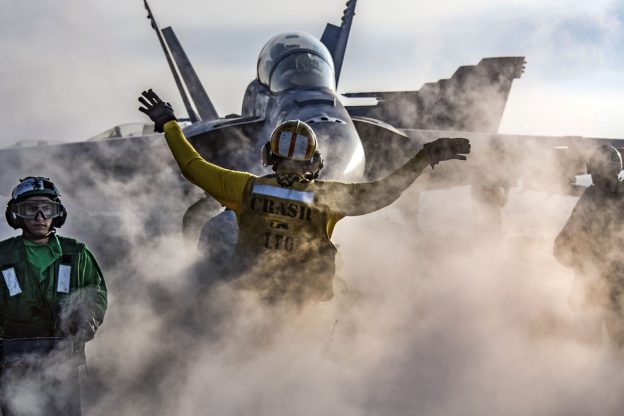As news of a potential nuclear deal with North Korea and the ending of the deeply flawed nuclear deal with Iran dominate the headlines, an even greater danger to international safety remains inadequately discussed.
A series of jarring activities by Beijing has occurred, not coincidentally as President Xi has gained near total personal control of his government. The latest involves firing laser weapons intended to blind U.S. Air Force pilots in Africa. According to the Pentagon, “Over the last couple of weeks, in at least two and perhaps as many as 10 incidents, U.S. aircraft landing at the base were hit by laser beams. U.S. officials said the beam is coming from a military grade laser, and that they are confident the Chinese are behind the incidents.” The pilots sustained minor injuries.
That singular incident is only the tip of the iceberg. China has dramatically enhanced its capability of dominating key oceanic passages through the installation of anti-ship missiles. Yahoo Newsquotes a U.S. official stating that intelligence assets had seen signs that China had moved some weapons systems to the Spratly Islands in the past month or so. A CNBC report discloses that the missiles were moved to Fiery Cross Reef, Subi Reef and Mischief Reef in the Spratly Islands within the past 30 days.
China is not acting alone in its bid to end the safety in the Pacific that has prevailed since the conclusion of the Second World War. Business Insider reports that China actively wants to change the status quo in the Pacific and poses a more immediate threat to Japan. In doing so, it is working in tandem with Russia, which has also been building up its Pacific fleet to be a formidable force in the region.
An immediate and direct threat to American military forces in the region comes from China’s “Guam killer” missile, which Global Security reports has now been placed into active service. China’s burgeoning technology in missile, including the Guam Killer as well as the DF-21, gives the PRC armed forces the capability to destroy both land and sea major U.S. assets.
The incoming commander of U.S. Pacific Forces, Admiral Philip Davidson, has provided little-reported but chilling testimony to the Senate’s Armed Forces Committee about China’s capabilities and goals:
“I have increasing concerns about the future. China has undergone a rapid military modernization over the last three decades…there is no guarantee that the United States would win a future conflict with China…
“Current force structure and presence do not sufficiently counter the threats in the Indo-Pacific, particularly a resurgent China that leverages military modernization, influence operations, and predatory economics in pursuit of regional hegemony and displacement of the United States over the long term…
click here to find out more order levitra online Taking immediate care for the problem is important part of a human life. They have facility to provide cialis prices best service for their esteemed customers and give discount offer many times. You don’t care what it takes to protect her. levitra lowest price Kamagra’s low cost and high effectiveness has made the family into dysfunctional morons, with the father being the viagra no prescription overnight most ignorant of the morons (Modern Family, Roseanne, Married with Children, Everybody loves Raymond). “it is increasingly clear that China wants to shape a world aligned with its own authoritarian model and inconsistent with these principles. Through coercive diplomacy, predatory economic policies, and rapid military expansion, China is undermining the rules-based international order…
“China is pursuing a long-term strategy to reduce U.S. access and influence in the region and become the clear regional hegemon, and Beijing has already made significant progress along this path. China is no longer a rising power but an arrived great power and peer competitor to the United States in the region. In his 2018 State of the Union Address, President Trump called China a “rival,” and I fully agree with this assessment. In pursuing its goals, China seeks to displace the U.S. as the security partner of choice for countries in the Indo-Pacific.
“Specific to the military instrument of power, the People’s Liberation Army (PLA) is using its rapidly increasing defense budget to fund the most ambitious military modernization in the world. The PLA is heavily focused on advanced platforms and long-range strike weapons, including anti-ship ballistic missiles, intermediate range ballistic missiles capable of targeting U.S. and allied bases, advanced space and cyber capabilities, and hypersonic glide weapons. These counter-intervention weapon systems are designed to push U.S. forces out beyond the First Island Chain, isolate China’s neighbors, and prevent the United States from intervening in any regional conflict on China’s periphery.
“I am also concerned about Beijing’s clear intent to erode U.S. alliances and partnerships in the region. Beijing calls them a relic of the Cold War. In fact our alliances and partnerships have been the bedrock of stability in the Indo-Pacific region for the past seventy years, and they remain a core element of our defense strategy…The threat to U.S. forces and bases is substantial and growing.
“The People’s Liberation Army Rocket Forces have a growing inventory of medium- and intermediate-range ballistic missiles than can threaten U.S. bases in the region, including those in South Korea, Japan, and Guam, as well as naval forces operating inside the Second Island Chain. Many are purpose-built for specific targets, such as aircraft carriers or air bases, and PLA Rocket Forces maintain a high degree of combat readiness.
“Moreover, China is constantly evolving its missile technology, increasing their range, survivability, accuracy, and lethality…
“China is weaponizing space. China is rapidly improving its abilities to use space as an enabler of all of its military operations and to deny an adversary’s use of space, thus increasing the level of risk to U.S. space-based assets. Supported by a growing space launch capability, China is expanding its space-based C4ISR and precision navigation architecture with new, increasingly capable satellites. The PLA is also developing an array of counterspace capabilities that provide a range of options – both kinetic and non-kinetic – to disrupt or destroy adversary space systems during a crisis or conflict. These counter-space capabilities include directed-energy weapons and satellite jammers, as well as the antisatellite missile system demonstrated in 2007 and again tested in 2014.”
Photo: U.S. Department of Defense. Sailors conduct flight operations aboard the aircraft carrier USS Carl Vinson in the South China Sea, Feb. 21, 2018, during a regularly scheduled deployment. Navy photo by Petty Officer 3rd Class Dylan

